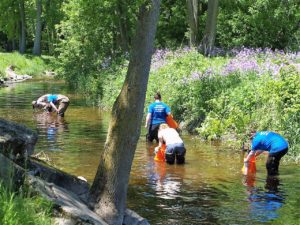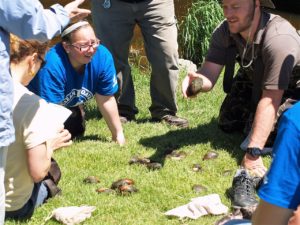Ripples from the Dunes, written by Mikayla Opichka and Anna Hall, summer interns at Woodland Dunes
Over the past few decades, much anxiety has been associated with the term “mussel” in the Great Lakes region. Many of us connect it with the invasive zebra mussels, which have been invading our water ecosystems and changing the lake environment drastically. However, not all mussels in the Great Lakes region are invasive. On the contrary, they are an essential aspect of a healthy aquatic landscape. They serve many purposes including, but not limited to, filtering water, being a food source for many animals, excreting readily used nutrients into the ecosystem, and provide an aquatic substrate for algae and insect larvae to attach to.

Searching for freshwater mussels
Last week, Woodland Dunes was very fortunate to have a mussel expert from the Department of Natural Resources(DNR) present information pertaining to the mussels of our region, and then followed up by guiding participants on a mussel survey of the East Twin River in Mishicot. The DNR has begun the Mussel Monitoring Program of Wisconsin, which has been studying all 51 native species of mussels in the area. All of these species have distinct environment preferences. Some of the species within Wisconsin include the Spike, Plain Pocketbook, Threeridge, Monkeyface, and the Creeper.
The mussel’s complex life cycle fascinated participants. The female mussel sits downstream waiting to catch its male counterpart’s gametes. The female must transfer the juvenile mussels to a host fish, where they will mature in the fish’s gills. She then uses an appendage called a lure that realistically imitates a small fish that bait larger fish. Once the host fish takes the bait, the sac explodes, bringing the juvenile mussels in contact with their host. When they are mature, they leave the host fish and begin their own adult mussel life within the substrate of the aquatic ecosystem. This process is an incredible example of evolution that has helped further the lives of successful mussels!
Everyone left with a new passion for freshwater mussels and the knowledge that these mussels are in our own backyards. The Wisconsin DNR is looking for volunteers who are interested in exploring the mussels of our region. Anyone can easily participate in this effort by stepping into the nearest body of water and searching for these freshwater critters. (It is helpful to have an aquascope to help view the underwater substrate, but if you do not have an aquascope, don’t fret! One can easily be created using household materials such as a milk jug, saran wrap, and rubber bands, or by using PVC pipe and plexiglass.) Once you have located a mussel, all you need to do is upload an image of the creature to the wildlife-centered social media platform called iNaturalist, which can be found on the web at iNaturalist.org and also on the App Store. This wonderful site will help identify the mussels as well as keep track of what species are located in each body of water.

Identifying freshwater mussels
A day spent outdoors is never wasted, and we encourage you to take some time to encounter these underwater wonders!
photos- Woodland Dunes staff and volunteers looking for freshwater mussels with Jesse Weinzinger of the Wisconsin DNR in the East Twin River, Mishicot; six different species of mussels found during program.
